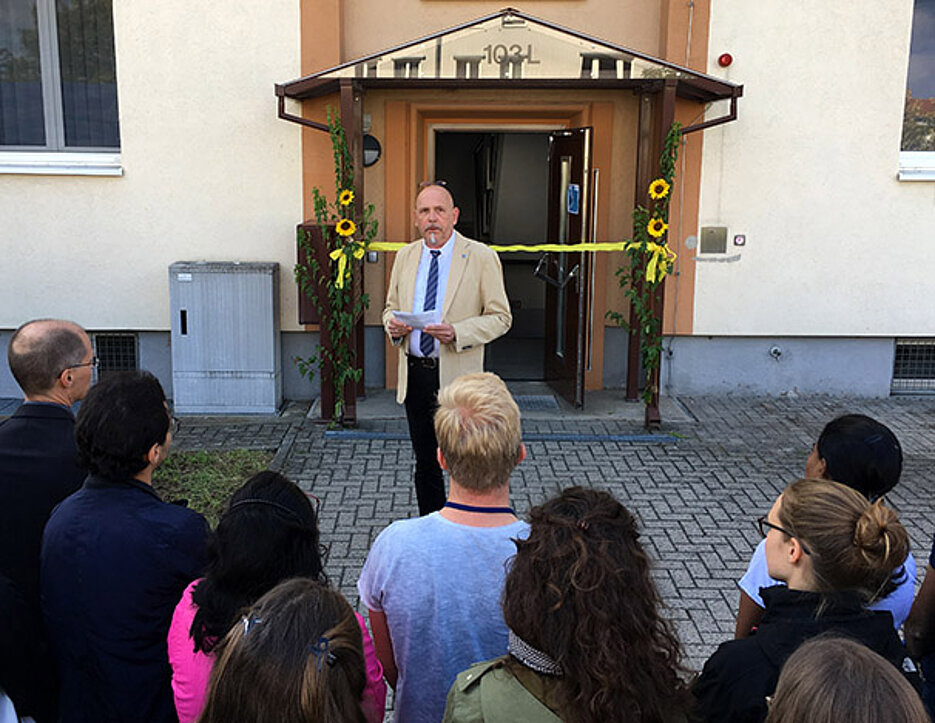A promising start: CCTB promotes young researchers
09/27/2016Back in 2014 already, the Faculty of Biology established the "Center for Computational and Theoretical Biology" (CCTB). On September 21, University President Alfred Forchel inaugurated the CCTB's new rooms on Hubland Nord campus.
The independent research unit comprises four junior professorships that represent different aspects of scientific computing. The CCTB will get privileged access to a new high-performance computer. Part of this computer platform is planned as the "Würzburg Biosciences Cloud" – a joint scientific project with the University of Würzburg's computing centre.
The inauguration ceremony was attended by President Forchel and University Chancellor Uwe Klug, the 25 students of the international summer school "Functional Genomics", Biology Dean Professor Thomas Rudel, Biology Vice Dean Professor Markus Engstler, the four holders of the junior professorships and other member of the Faculty of Biology. "The CCTB was their idea and they were highly committed to making it happen," Forchel said at the inauguration and highlighted the proactive work of everyone involved from the field of study. As in all other scientific disciplines, data volumes have been growing considerably. The CCTB aims to find computer-based solutions to process these data efficiently.
Young researchers and modern teaching methods are the hallmarks of the CCTB
Markus Engstler, Biology Vice Dean, outlines the CCTB's concept which seems risky at first glance only according to the professor. "We opted to staff and finance four junior professorships. At the same time, we hired ten 'liaison PhD students' in biology." Their job is to liaise with the other biology departments on behalf of the CCTB and they also receive support from the CCTB professorships. So far the concept seems to be successful: Backed by the university and the faculty, the CCTB has won excellent young scientists. "The president and the dean recognised the idea's potential at an early stage and supported us accordingly," Engstler said.
The CCTB's contents were deliberately chosen to encompass a great variety of subjects. From genome research and image analysis to cell system simulation and ecosystem modelling: "We want to fuel the exchange between the disciplines," Engstler said. This also includes interacting with students of various academic backgrounds such as biology, bioinformatics, mathematics, physics or medicine. The CCT has a seminar room equipped with cutting-edge IT technology: Students connect to a terminal server via thin clients allowing the lecturer to monitor the progress of each participant and visualise it on-screen for discussion in the group.
Markus Engstler co-manages the CCTB with Thomas Dandekar and Jörg Schultz, both Professors of Bioinformatics. Presently, financing is secured for six years and Engstler takes a positive view of the future: "Our goal is to do first-class research and we have a very special spirit here. From experience, I can tell that there will be opportunities."
Junior professorships cover a wide field
The four junior professors are: Franziska Matthäus, Juliano Sarmento Cabral, Philip Kollmannsberger and Arthur Korte. Matthäus' interest is cell movement. With her research team she has among others developed models for the motile behaviour of Escherichia-coli bacteria. "We studied the individual bacteria cells and larger populations and we also took the regulatory signal processing in the bacteria into account," the biophysicist says. For example, she examined how the cells perceive the change in the concentration of chemical attractants and align to them.
Juliano Sarmento Cabral is a junior professor for ecosystem modelling. His motto: Anyone who wants to research ecosystems and their dynamics needs a thorough understanding of the processes going on inside the systems. Sarmento Cabral collects the required knowledge during field research but also using theoretical computer models and simulations. "In the simulation experiments, we create a virtual world inside the computer," he explains. The simulations are used to determine how varying temperatures, humidity or other environmental factors affect plants and animals. The new junior professor will also be involved in teaching by holding lectures on ecology and ecological modelling.
Philip Kollmannsberger is interested in a physical aspect of biology which he believes is highly underestimated: the role of mechanical forces and how to make them "visible" under the microscope using quantitative image analysis. Such forces are at play for instance when tumour cells penetrate healthy tissue, when bone tissue regenerates or when bacteria and immune cells interact. "I develop methods to analyse and quantify biological image data, especially from microscopy," Kollmannsberger says.
Artur Korte looks into the question of which genetic variations allow plants to better cope with dry conditions. This question is highly relevant in the face of climate change. The guard cells play a crucial role when dealing with water scarcity: They allow plants to limit the loss of water to the environment. "Regulating these cells is one of the most important processes for plants in order to adjust to varying environmental conditions," Arthur Korte explains. He wants to get a better understanding of the mechanism. For this purpose, he has specialised in guard cell regulation: "My focus is on identifying natural gene variants that provide the plant an evolutionary advantage with regard to saving water."
Contact







